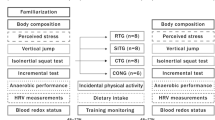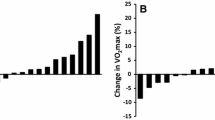Abstract
Purpose
The present study examined the effect of reducing sprint interval training (SIT) work-interval duration on increases in maximal and submaximal performance.
Methods
Subjects (n = 36) were assigned to one of three training groups: endurance training (ET; 60 min per session for weeks 1–2, increasing to 75 min per session for weeks 3–4), or sprint interval training consisting of either repeated 30 (SIT 30) or 15 (SIT 15) second all-out intervals (starting with 4 bouts per session for weeks 1–2, increasing to 6 intervals per session for weeks 3–4). Training consisted of cycling 3 times per week for 4 weeks.
Results
While there was a significant main effect of training on \(\dot{V}{\text{O}}_{{{\text{2peak}}}}\) such that \(\dot{V}{\text{O}}_{{{\text{2peak}}}}\) was elevated post-training, no significant difference was observed in the improvements observed between groups (ET ~13 %, SIT 30–4 %, SIT 15–8 %). A significant main effect of training was observed such that lactate threshold and critical power were higher during post-testing across all groups (p < 0.05). There was a main effect of training (p < 0.05) on Wingate peak power with no differences observed between groups at post-training.
Conclusions
Together, these results indicate that reducing SIT work-interval duration from 30 to 15 s had no impact on training-induced increases in aerobic or anaerobic power, or on increases in lactate threshold (absolute) and critical power.





Similar content being viewed by others
Abbreviations
- ANOVA:
-
Analysis of variance
- BMI:
-
Body mass index
- CO:
-
Cardiac output
- CP:
-
Critical power
- ET:
-
Endurance training
- HIT:
-
High-intensity interval training
- HR:
-
Heart rate
- PGC 1-α:
-
Peroxisome proliferator-activated receptor gamma coactivator 1-alpha
- RER:
-
Respiratory exchange ratio
- SIT:
-
Sprint interval training
- SV:
-
Stroke volume
- WR:
-
Work rate
References
Adams OP (2013) The impact of brief high-intensity exercise on blood glucose levels. Diabetes Metab Syndr Obes Targets Ther 6:113–122. doi:10.2147/DMSO.S29222
Bangsbo J, Gunnarsson TP, Wendell J, Nybo L, Thomassen M (2009) Reduced volume and increased training intensity elevate muscle na+-K+ pump alpha2-subunit expression as well as short- and long-term work capacity in humans. J Appl Physiol (Bethesda, Md.: 1985) 107(6):1771–1780. doi:10.1152/japplphysiol.00358.2009
Barnett C, Carey M, Proietto J, Cerin E, Febbraio MA, Jenkins D (2004) Muscle metabolism during sprint exercise in man: influence of sprint training. J Sci Med Sport Sports Med Aust 7(3):314–322
Bhambhani Y, Norris S, Bell G (1994) Prediction of stroke volume from oxygen pulse measurements in untrained and trained men. Can J Appl Physiol 19(1):49–59
Bishop D, Jenkins DG, Mackinnon LT (1998) The relationship between plasma lactate parameters, wpeak and 1-h cycling performance in women. Med Sci Sports Exerc 30(8):1270–1275
Boyd JC, Simpson CA, Jung ME, Gurd BJ (2013) Reducing the intensity and volume of interval training diminishes cardiovascular adaptation but not mitochondrial biogenesis in overweight/obese men. PLoS One 8(7):e68091. doi:10.1371/journal.pone.0068091
Burgomaster KA, Hughes SC, Heigenhauser GJ, Bradwell SN, Gibala MJ (2005) Six sessions of sprint interval training increases muscle oxidative potential and cycle endurance capacity in humans. J Appl Physiol (Bethesda, Md.: 1985) 98(6):1985–1990. doi:10.1152/japplphysiol.01095.2004
Burgomaster KA, Heigenhauser GJ, Gibala MJ (2006) Effect of short-term sprint interval training on human skeletal muscle carbohydrate metabolism during exercise and time-trial performance. J Appl Physiol (Bethesda, Md.: 1985) 100(6):2041–2047. doi:10.1152/japplphysiol.01220.2005
Burgomaster KA, Howarth KR, Phillips SM, Rakobowchuk M, Macdonald MJ, McGee SL, Gibala MJ (2008) Similar metabolic adaptations during exercise after low volume sprint interval and traditional endurance training in humans. J Physiol 586(1):151–160. doi:10.1113/jphysiol.2007.142109
Conley KE, Kemper WF, Crowther GJ (2001) Limits to sustainable muscle performance: interaction between glycolysis and oxidative phosphorylation. J Exp Biol 204(Pt 18):3189–3194
Dalleck L, Bushman TT, Crain RD, Gajda MM, Koger EM, Derksen LA (2010) Dose–response relationship between interval training frequency and magnitude of improvement in lactate threshold. Int J Sports Med 31(8):567–571. doi:10.1055/s-0030-1254136
Ekkekakis P, Hall EE, Petruzzello SJ (2008) The relationship between exercise intensity and affective responses demystified: to crack the 40-year-old nut, replace the 40-year-old nutcracker! Ann Behav Med 35(2):136–149. doi:10.1007/s12160-008-9025-z
Esfarjani F, Laursen PB (2007) Manipulating high-intensity interval training: effects on VO2max, the lactate threshold and 3000 m running performance in moderately trained males. J Sci Med Sport Sports Med Aust 10(1):27–35. doi:10.1016/j.jsams.2006.05.014
Gaesser GA, Angadi SS (2011) High-intensity interval training for health and fitness: can less be more? J Appl Physiol (Bethesda, Md.: 1985) 111(6):1540–1541. doi:10.1152/japplphysiol.01237.2011
Gibala MJ, Little JP, van Essen M, Wilkin GP, Burgomaster KA, Safdar A, Tarnopolsky MA (2006) Short-term sprint interval versus traditional endurance training: similar initial adaptations in human skeletal muscle and exercise performance. J Physiol 575(Pt 3):901–911. doi:10.1113/jphysiol.2006.112094
Gibala MJ, Little JP, Macdonald MJ, Hawley JA (2012) Physiological adaptations to low-volume, high-intensity interval training in health and disease. J Physiol 590(Pt 5):1077–1084. doi:10.1113/jphysiol.2011.224725
Gollnick PD, Piehl K, Saltin B (1974) Selective glycogen depletion pattern in human muscle fibres after exercise of varying intensity and at varying pedalling rates. J Physiol 241(1):45–57
Harmer AR, McKenna MJ, Sutton JR, Snow RJ, Ruell PA, Booth J, Eager DM (2000) Skeletal muscle metabolic and ionic adaptations during intense exercise following sprint training in humans. J Appl Physiol (Bethesda, Md.: 1985) 89(5):1793–1803
Hazell TJ, Macpherson RE, Gravelle BM, Lemon PW (2010) 10 or 30-s sprint interval training bouts enhance both aerobic and anaerobic performance. Eur J Appl Physiol 110(1):153–160
Holloszy JO, Coyle EF (1984) Adaptations of skeletal muscle to endurance exercise and their metabolic consequences. J Appl Physiol Respir Environ Exerc Physiol 56(4):831–838
Jansson E, Esbjornsson M, Holm I, Jacobs I (1990) Increase in the proportion of fast-twitch muscle fibres by sprint training in males. Acta Physiol Scand 140(3):359–363. doi:10.1111/j.1748-1716.1990.tb09010.x
Jenkins DG, Quigley BM (1992) Endurance training enhances critical power. Med Sci Sports Exerc 24(11):1283–1289
Laursen PB, Jenkins DG (2002) The scientific basis for high-intensity interval training: optimising training programmes and maximising performance in highly trained endurance athletes. Sports Med (Auckland, N.Z.) 32(1):53–73
MacDougall JD, Hicks AL, MacDonald JR, McKelvie RS, Green HJ, Smith KM (1998) Muscle performance and enzymatic adaptations to sprint interval training. J Appl Physiol (Bethesda, Md.: 1985) 84(6):2138–2142
Macpherson RE, Hazell TJ, Olver TD, Paterson DH, Lemon PW (2011) Run sprint interval training improves aerobic performance but not maximal cardiac output. Med Sci Sports Exerc 43(1):115–122. doi:10.1249/MSS.0b013e3181e5eacd
McKay BR, Paterson DH, Kowalchuk JM (2009) Effect of short-term high-intensity interval training vs. continuous training on O2 uptake kinetics, muscle deoxygenation, and exercise performance. J Appl Physiol (Bethesda, Md.: 1985) 107(1):128–138. doi:10.1152/japplphysiol.90828.2008
Messonnier LA, Emhoff CA, Fattor JA, Horning MA, Carlson TJ, Brooks GA (2013) Lactate kinetics at the lactate threshold in trained and untrained men. J Appl Physiol (Bethesda, Md.: 1985) 114(11):1593–1602. doi:10.1152/japplphysiol.00043.2013
Metcalfe RS, Babraj JA, Fawkner SG, Vollaard NB (2012) Towards the minimal amount of exercise for improving metabolic health: beneficial effects of reduced-exertion high-intensity interval training. Eur J Appl Physiol 112(7):2767–2775. doi:10.1007/s00421-011-2254-z
Mohr M, Krustrup P, Nielsen JJ, Nybo L, Rasmussen MK, Juel C, Bangsbo J (2007) Effect of two different intense training regimens on skeletal muscle ion transport proteins and fatigue development. Am J Physiol Regul Integr Comp Physiol 292(4):R1594–R1602. doi:10.1152/ajpregu.00251.2006
Poole DC, Ward SA, Gardner GW, Whipp BJ (1988) Metabolic and respiratory profile of the upper limit for prolonged exercise in man. Ergonomics 31(9):1265–1279. doi:10.1080/00140138808966766
Poole DC, Ward SA, Whipp BJ (1990) The effects of training on the metabolic and respiratory profile of high-intensity cycle ergometer exercise. Eur J Appl Physiol 59(6):421–429
Richardson RS, Harms CA, Grassi B, Hepple RT (2000) Skeletal muscle: master or slave of the cardiovascular system? Med Sci Sports Exerc 32(1):89–93
Russell AP, Feilchenfeldt J, Schreiber S, Praz M, Crettenand A, Gobelet C, Deriaz O (2003) Endurance training in humans leads to fiber type-specific increases in levels of peroxisome proliferator-activated receptor-gamma coactivator-1 and peroxisome proliferator-activated receptor-alpha in skeletal muscle. Diabetes 52(12):2874–2881
Shepherd SO, Cocks M, Tipton KD, Ranasinghe AM, Barker TA, Burniston JG, Shaw CS (2013). Sprint interval and traditional endurance training increase net intramuscular triglyceride breakdown and expression of perilipin 2 and 5. J Physiol 591(Pt 3):657–675. doi:10.1113/jphysiol.2012.240952
Sloth M, Sloth D, Overgaard K, Dalgas U (2013) Effects of sprint interval training on VO2max and aerobic exercise performance: a systematic review and meta-analysis. Scand J Med Sci Sports 23(6):e341–e352. doi:10.1111/sms.12092
Spriet LL, Howlett RA, Heigenhauser GJ (2000) An enzymatic approach to lactate production in human skeletal muscle during exercise. Med Sci Sports Exerc 32(4):756–763
Vanhatalo A, Doust JH, Burnley M (2007) Determination of critical power using a 3-min all-out cycling test. Med Sci Sports Exerc 39(3):548–555. doi:10.1249/mss.0b013e31802dd3e6
Vanhatalo A, Doust JH, Burnley M (2008) A 3-min all-out cycling test is sensitive to a change in critical power. Med Sci Sports Exerc 40(9):1693–1699. doi:10.1249/MSS.0b013e318177871a
Vollestad NK, Tabata I, Medbo JI (1992) Glycogen breakdown in different human muscle fibre types during exhaustive exercise of short duration. Acta Physiol Scand 144(2):135–141. doi:10.1111/j.1748-1716.1992.tb09278.x
Warburton DE, McKenzie DC, Haykowsky MJ, Taylor A, Shoemaker P, Ignaszewski AP, Chan SY (2005) Effectiveness of high-intensity interval training for the rehabilitation of patients with coronary artery disease. Am J Cardiol 95(9):1080–1084. doi:10.1016/j.amjcard.2004.12.063
Whipp BJ, Higgenbotham MB, Cobb FC (1996) Estimating exercise stroke volume from asymptotic oxygen pulse in humans. J Appl Physiol (Bethesda, Md.: 1985) 81(6):2674–2679
Wisloff U, Stoylen A, Loennechen JP, Bruvold M, Rognmo O, Haram PM, Skjaerpe T (2007) Superior cardiovascular effect of aerobic interval training versus moderate continuous training in heart failure patients: A randomized study. Circulation 115(24):3086–3094. doi:10.1161/CIRCULATIONAHA.106.675041
Acknowledgements
We are grateful to a dedicated group of volunteers for their help in conducting training sessions.
Conflict of interest
There were no conflicts of interest.
Author information
Authors and Affiliations
Corresponding author
Additional information
Communicated by Nicolas Place.
Rights and permissions
About this article
Cite this article
Zelt, J.G.E., Hankinson, P.B., Foster, W.S. et al. Reducing the volume of sprint interval training does not diminish maximal and submaximal performance gains in healthy men. Eur J Appl Physiol 114, 2427–2436 (2014). https://doi.org/10.1007/s00421-014-2960-4
Received:
Accepted:
Published:
Issue Date:
DOI: https://doi.org/10.1007/s00421-014-2960-4




